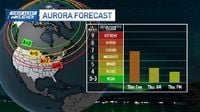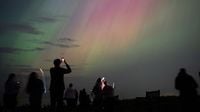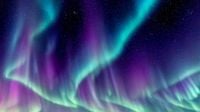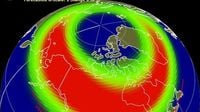Skywatchers across the United States are gearing up for a spectacular display of the northern lights, also known as the aurora borealis, expected to grace the skies on Wednesday, April 16, 2025. The phenomenon is anticipated to be visible on two consecutive nights, starting late Tuesday, April 15, and continuing into Wednesday night, according to the National Oceanic and Atmospheric Administration's Space Weather Prediction Center.
The auroras are caused by charged particles from the sun interacting with Earth’s atmosphere. "The Sun continuously produces an outflow of charged particles into the solar system known as the solar wind," NASA explains. "When the solar wind reaches Earth, it can interact with Earth's magnetic shield, often depositing and accumulating energy there. When this energy is finally released, much of it rains down on our atmosphere, causing auroras." This mesmerizing display of color has captivated humanity for thousands of years.
Recent geomagnetic storms have allowed these lights to be visible much farther south than usual, even reaching as far as northern Florida. This uptick in visibility is linked to the sun currently being at its "solar maximum," the most active phase in its 11-year cycle. The display is expected to peak on Wednesday, potentially stretching across up to 18 states before tapering off to just four states by Thursday, April 17.
According to NOAA, the best time to view the aurora is typically between 10 p.m. and 2 a.m. local time, with the most vibrant displays happening within an hour or two of midnight. While auroras can sometimes be seen in the early evening or early morning, they tend to be less active and visually striking during those hours.
The states most likely to catch a glimpse of the northern lights include Alaska, Montana, North Dakota, Minnesota, Wisconsin, Michigan, Maine, Washington, Idaho, Oregon, Vermont, New Hampshire, New York, Pennsylvania, South Dakota, Iowa, Illinois, and Nebraska. To increase your chances of witnessing this stunning natural event, head out to a location far from city lights, as light pollution can significantly diminish the visibility of the auroras.
However, it's important to note that a full moon can wash out the view, making it harder to see the lights. High-latitude regions, where auroras are common, do not experience true darkness in the summer, which makes summer trips to these areas less ideal for aurora viewing. While the lights might still be present, they are only visible in the dark, according to NOAA.
NASA emphasizes that since auroras occur far above the clouds, clear skies and favorable space weather are essential for optimal viewing. Patience and a bit of luck are also crucial. Interestingly, your smartphone can be a useful tool for capturing the auroras, as its camera is often more sensitive than the human eye and may pick up dim displays that would otherwise go unnoticed.
In addition to the stunning visuals, the solar storm generating the auroras may have some effects on technology. The strong solar storm has been classified as a level 3 on a scale from 1 to 5 and could disrupt satellites, GPS, radio signals, and even power grids on Earth. The Space Weather Prediction Center issued a strong geomagnetic storm watch on Tuesday after multiple coronal mass ejections (CMEs) from the sun arrived earlier than anticipated.
CMEs are large clouds of ionized gas, or plasma, and magnetic fields that erupt from the sun's outer atmosphere. When directed at Earth, these outbursts can lead to geomagnetic storms, which disturb Earth's magnetic field. Minor geomagnetic storm conditions are expected to continue through Thursday, April 17, suggesting that if the skies are cloudy on Wednesday night, there may still be a chance to see the auroras on Thursday night.
Historically, the past year has seen an increase in northern lights viewings, attributed to heightened solar activity. A rare extreme geomagnetic storm, classified as level 5, struck Earth in May 2024, allowing auroras to be seen in areas that typically do not experience them. During that storm, some GPS-dependent customers, including those in precision farming, reported disruptions. Fortunately, power grid and satellite operators managed to keep their systems running smoothly despite the intense geomagnetic currents.
With the current solar activity, researchers have noted an increase in solar flares and CMEs, leading to more frequent and intense auroras. For instance, a severe geomagnetic storm last October triggered auroras across much of the United States, showcasing the sun's potential to create breathtaking light shows.
As for the current aurora forecast, the K-index, which measures the strength of geomagnetic storms, has shown an increase into moderate territory and is expected to rise into the strong category. This means that the chances of seeing the aurora borealis are significantly heightened, especially in northern regions.
In Western New York, for example, cloud cover is a major factor that could hinder visibility. While conditions are expected to clear up around midnight, giving residents a chance to see the auroras on the northern horizon, many are still hopeful. Experts recommend getting away from city lights to find dark locations free from light pollution for the best viewing experience.
As the excitement builds for this celestial event, skywatchers are encouraged to stay informed through resources like the NOAA Space Weather Prediction Center's aurora dashboard, which provides real-time updates on aurora visibility. Even if the lights are faint to the naked eye, camera sensors can often capture them, allowing enthusiasts to still enjoy the spectacle.
With heightened geomagnetic activity expected in the coming days, the northern lights are set to dazzle audiences across the United States, making it an exciting time for both seasoned aurora hunters and newcomers alike. Whether you’re planning to bundle up and venture outside or simply watch from the comfort of your home, the auroras promise to be a sight to behold.




